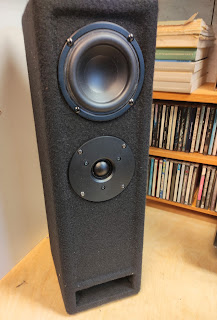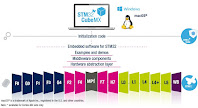Linear phase EQ, part 1
First let's talk about EQ in general:
A few decades of running a sound-rental left me with a huge collection of superfluous copies of several brands of 31b. graphic EQ'sMy personal favorite was such a KT DN360-->
What was (still is??) the purpose of a 31b. EQ inserted in the mains of our PA's?
Often people start jabbing about room EQ, tuning a system to a room or other semi scientific nonsense never leaving out to mention phase issues..
Once you grow to be a bit more aware about what you are doing you will realize that the use of such a graphic has (had) two purposes:
1. you will use it in the creative process of doing your mix
2. you will try to correct problems you are experiencing with the current program material, the system (and the level)
The first one is not at debate here, let's investigate the second topic.
Loudspeaker systems in general are giant distortion generators (as compared to electronics). To elaborate on the cause or specify what distortion would lead way to far in this article, just bare with me and do understand that we are not talking about rattle and buzzes but the harmonic distortion as we sometimes also appreciate.
So with this in mind we could agree that the tweaking in the 2-4kHz region on your graphic might be triggered by the perceived distortion.. NOT the level..
If you remember: you dipped that frequency because it was 'ugly' not because it was 'loud'
All analog EQ's and the mayor part of it's digital counterpart are min. phase. Meaning: yes, every EQ setting will affect the phase in that region in a way as is associated with it's magnitude response. Law of physics. Mostly no problem as in the thing you are correcting will be min. phase too.
The example above: using your EQ to dip those ugly distortion will affect phase in a way you don't want. Maybe that's the reason you keep tweaking in that region during a 'difficult' show.
Another reason why you keep changing the EQ settings in that region could be Fletcher + Munson. Everybody knows these equal-loudness contours. The 'loudness' button on your '70's hifi amp is a direct consequence.
Look closely in the 2-4kHz region, not only your hearing is more sensitive in that aria (duh) :
Also that sensitivity changes with level both in freq. and amount. Go from 80 to 100 dB to get an idea.
We do have tried different solutions for this. I never was happy with any dynamic EQ or desser function on any compressor of any of the shelf product.
Multiband compressor techniques are more something I could appreciate. True lin. phase that is! Here is an example of a way I did this using a free programming platform like BSS soundweb:
The signal is split in two pathways by using lin. phase FIR filters. Great care has been taken those filters when recombined don't affect the signal in any other way then adding in some delay. Both paths are compressed with different settings for attack, release, rating and so on. The compressor is made more 'sensitive' for the freq. of interest by using an EQ on the side chain (having its split feed before the FIR will give it some 'look ahead')Still not quit happy as in you don't want a 'compressor' action, you want 'EQ' action.
So recently I started to experiment with my home brewn DSP boards. I took a metal horn driver combo, despite the felt damping it will have a ringing-bell associated distortion, certainly if it is not mounted firmly in a box. (still a really nice, controlled top end, though)
..soon more
.jpg)











































